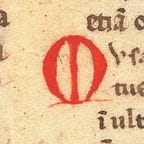Liber Floridus: the Lunar Month
Liber Floridus (“Book of Flowers”) is a medieval encyclopedia compiled by Lambertus a S. Audomaro in the XII Century. This diagram is from the original manuscript Ghent, University Library, MS 92.
The text has been integrated with the later copy Wolfenbüttel Cod Guelf., 1 Gud lat., Catalog №4305.
Page title: CvRs9 LvNaRis Et AnNi DeSCriPtiO
A description of the Lunar cycle and of the year
[Above the diagram] Transcription: Luna proprium non habet lumen. Sed in modum speculi irradiata a sole resplendet. / Numquam ab eo totus tegi aut occultare potest Hilperico testante; Sol radios suos etiam cum sub terra esset undique ad superiora remittit.
Translation: The Moon does not have light of its own. But it shines as a mirror when it is irradiated by the Sun. As Helperic says, the Moon can never be entirely covered or hidden by the Sun. The Sun sends its rays above in all directions even when it is below the earth [i.e. at night].
[Below the diagram, from the Wolfenbüttel manuscript] Transcription: Luna dicta quasi lucina eo quod a sole lumen recipiat. Lune eclypsis est quociens in umbram terre luna incurrit. Annus lunaris annus brevis dicitur quia luna ceteris sideribus terris vicinior in breviori orbe celerius peragit cursum suum videlicet triginta diebus vel viginti novem. Lunam terra maiorem Beda affirmat. Quod enim sol percurrit trecentis sexaginta diebus, Luna currit in uno mense lunari, qui mensis annus lunaris dicitur.
Translation: The Moon is called “a small light” because it receives its light from the Sun. Lunar eclipses happen when the Moon finds itself in the shadow of the Earth. The Lunar year is called “short year” because the Moon is faster than the other astral bodies: being closer to Earth, it runs a smaller circle in a shorter time, i.e. thirty or twenty-nine days. Bede says that the Moon is larger than the Earth. What the Sun travels in three hundred sixty days, the Moon travels in a single Lunar month: a month is called “a lunar year”.
The diagram
Outer circle: Roman numbers corresponding to the 31 “phases of the moon” illustrated in the blue circle.
Red circle and personifications of the winds (clockwise from the top): Oriens (East) / Subsolanus; in the green area “Dies” (day); Auster Brumalis (Southern wintry wind) / Fabonius; in the green area: “Solis Occasum” (sunset) — also marked “Luna” (moon); Occidens Solstitialis (sunset point at the solstice, i.e. West) / Nothus; green area: Nox (night); Solsticium / Septentrio (North); green area: Solis Ortus (rising sun).
The eight areas of the inner circle list the four elements and the four seasons, connecting them with the four Galenic qualities: Ignis, Calidus; Estas, Calidus; Autmnus, Sicca; Ventus, Sicca; Aer, Frigidus; Hiemps, Frigidus; Ver, Humidus; Aqua, Humidus;
Fire, Hot; Summer, Hot; Autumn, Dry; Wind, Dry; Air, Cold; Winter, Cold; Spring, Wet; Water, Wet.
It is peculiar that “wind” replaces “earth” among the elements.
The centre of the diagram is labelled “Annus” (Year) as a title for the whole diagram.
The outer circle describes the rotation of the moon around the earth, resulting in the lunar month. The varying position of the moon with respect to the sun during the month causes the lunar phases illustrated in the blue circle. The inner part of the diagram is about the (apparent) rotation of the sun around the earth, i.e. the solar year. The year is divided into four equal parts (the season) and put in relation with other four-fold systems: the elements, the cardinal points, the winds, the Galenic qualities.
